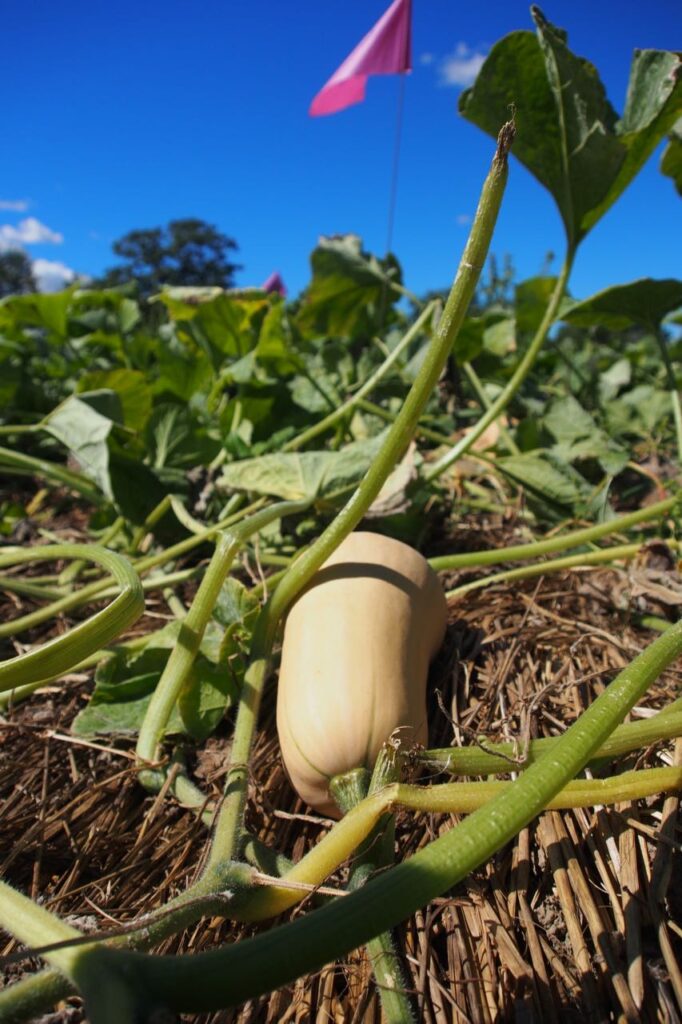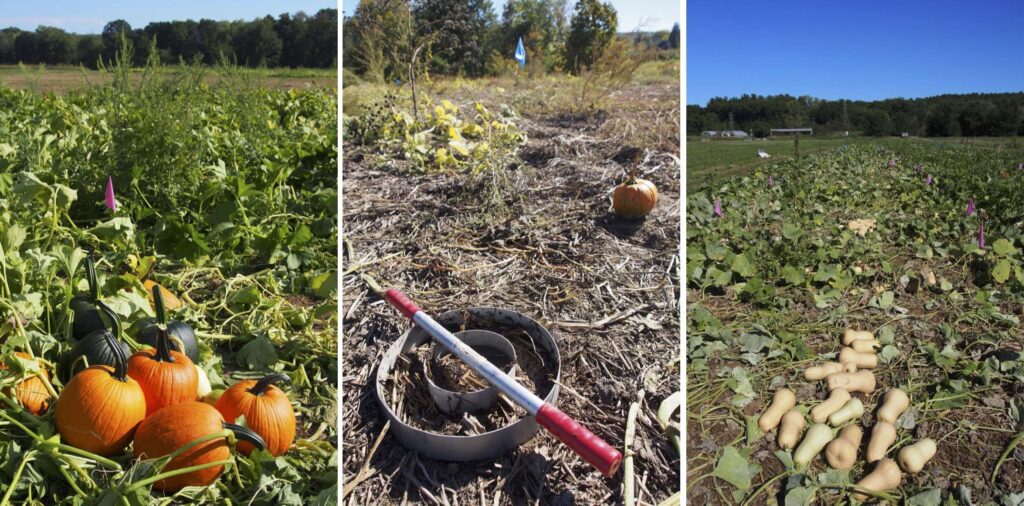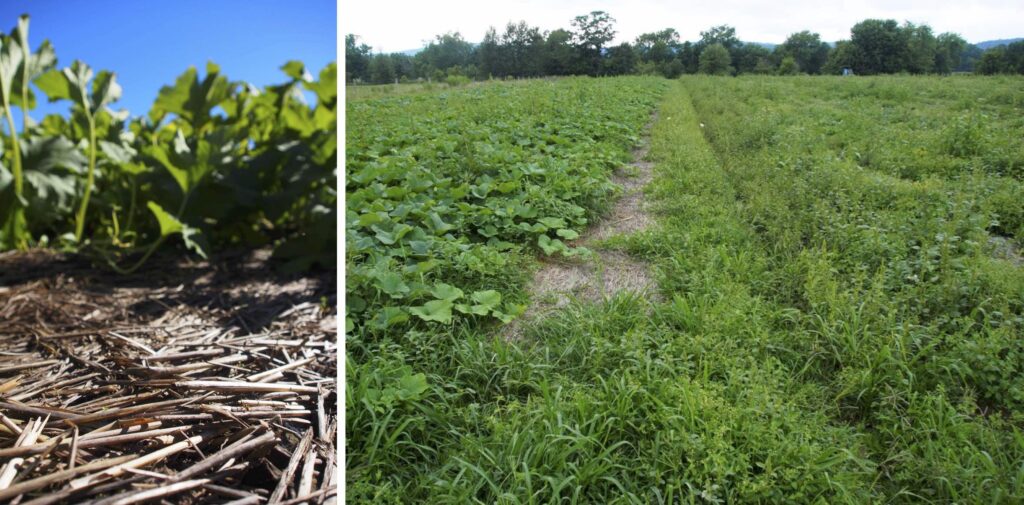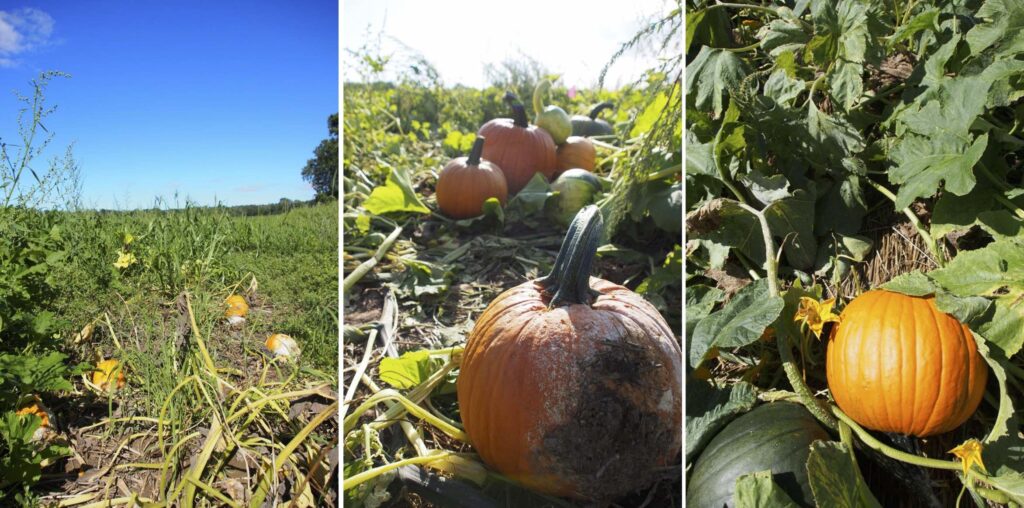2016 Annual Report for LNE14-335
Integrated Phytophthora blight management in vegetable crops with enhanced soil health from cover crops, reduced tillage, and brassica biofumigation
Summary
 Healthy butternut squash atop rolled rye mulch in reduced tillage treatment, Hudson Valley, 2016.
Healthy butternut squash atop rolled rye mulch in reduced tillage treatment, Hudson Valley, 2016.
The crop disease Phytophthora blight (PB) is a potentially devastating disease and top concern for vegetable growers in the Northeast (including the northeastern Midwest) where susceptible cucurbit and nightshade species of crops contribute to major portions of farm incomes and to the greater vegetable industry. Soil health improvement has been proposed as a fundamental component of an integrated PB and general soil-borne disease management program. Certain brassica cover crops are capable of providing biofumigation services to soils with high soil-borne pathogen loads, and reduced tillage (RT) can allow for soils to regenerate functions that further mitigate soil-borne diseases. This project is aimed at increasing grower awareness and adoption of integrated PB and general soil-borne disease management through demonstration and research trials that combine the novel components 1) of biofumigation with brassica cover crops and 2) reduced tillage (RT) on six NY farms and at Cornell’s Long Island Horticultural Research and Extension Center (LIHREC).
By the end of 2015, seven collaborating growers had completed a total of 13 on-farm trials with brassica cover crops for biofumigation. Throughout winter 2016, biofumigation information and preliminary 2015 trial results were disseminated to a minimum of ~285 growers via educational events. In 2016, four remaining grower collaborators (from trial year 2015) followed their biofumigation trial year with RT treatments; one grower in Long Island opted out of the RT trial year, and two former grower collaborators from western New York failed to successfully implement the RT component at their sites.
All four collaborating growers successfully completed a RT vs. “grower standard” control comparison with a cucurbit response crop across nine total replications. The research team collected data on cover crop biomass, yield, PB incidence, soil infiltration rates, and a soil health assay in 2016. Similar to 2015, weather was not conducive to a proliferation of PB at the trial sites. Phytophthora incidence was therefore low, and, at most sites, non-existent; our ability to collect evidence of treatment effects related to Phytophthora was therefore reduced again in 2016. Results will be analyzed and educational materials developed throughout 2017. In addition to growers that tried brassica cover crops for biofumigation in 2015 (see 2015 report), 2-3 more growers in the Hudson Valley region were noted to have informally tried ‘Caliente’ mustard for biofumigation for the first time in 2016 as a result of this project.
Objectives/Performance Targets
Forty vegetable growers across three regions of NY will integrate multiple soil-borne disease management practices that may include biofumigation with brassica cover crops and reduced tillage on at least an 5 acres per farm, recovering $1000 – $4000 per acre otherwise spent and/or lost on diseases like Phytophthora blight.
Accomplishments/Milestones
1) Six growers battling Phytophthora blight (PB) in three distinct regions of NY are recruited by Extension and guided through the process of choosing treatments and establishing a trial including a brassica cover crop for biofumigation and reduced tillage. September 2014 – April 2015.
This milestone was completed for the 2015 trial year- seven (of a targeted six) growers trialled brassica cover crops for biofumigation vs. their standard practice in 2015. Three grower collaborators from 2016 chose not to continue the trials into 2016 leaving us with four (of a targeted six) collaborating growers for the reduced tillage (RT) portion of the trials. To offset the loss of data from lost grower collaborator trial sites, the remaining collaborators were encouraged to implement more than one replication at their site in the 2016; at the Hudson Valley sites, one grower established two replications (of which, one was compromised), another grower established three replications, while another was able to establish four.
 Data collection in 2016 on-farm trials showing yield and soil infiltration rate sampling.
Data collection in 2016 on-farm trials showing yield and soil infiltration rate sampling.
2) 75 growers attend field days (25/region) and learn about PB and integrated approaches to managing PB and soil-borne diseases through viewing trials and from the project’s grower collaborators and research team. June 2015.
The project team added at least 60 grower contacts to this milestone through three regional grower twilight meetings in summer 2015; ~110 growers were previously introduced to the project and its components before the 2015 summer meetings.
3) 300 growers total attending winter conference/meeting presentations will learn about integrated approaches to managing PB and soil-borne diseases and year 1 trial results. January-March 2016.
Presentations during winter of 2016 disseminated information on biofumigation practices and preliminary trial results, reaching at least ~285 growers (and other stakeholders). The presentations were given in a statewide grower conference in Central NY, at a regional grower meeting and a statewide conference in NY’s Capital District region, and at another grower meeting in NY’s Hudson Valley region in 2016. A link to the one of the project-related presentations given in 2016 is provided below, at end of this section.
4) 75 growers attend field days (25/region) and learn about PB and integrated approaches to managing PB and soil-borne diseases through viewing trials and from the project’s grower collaborators and research team. June 2016.
Due to 1) project demonstration and dissemination events in summer 2015, 2) a considerable project information dissemination effort at 2016 winter meetings, and 3) a lack of new information from the project to share, the research team opted to refrain from holding dedicated project-related summer demonstration events in 2016. We alternatively decided to bring in out-of-state guest speakers to talk about the components related to the project (see Milestone 5), and to hold project demonstration events only after we have new project information to share in 2017. If funds allow, we will also try to purchase a small amount of seed for on-farm demonstration plots to accompany 2017 grower events across the state. The project efforts were nonetheless shared once this summer at a general IPM grower event in the Hudson Valley, and at two other general IPM grower events in western NY, reaching an additional ~70 growers and stakeholders total. The western NY region would have benefited from a demonstrative event in 2016, but their demonstration sites were lost. To help compensate for these lost trial/demonstration sites, we alternatively have decided to make an extra effort to disseminate project-related information and final project results throughout 2017 in western NY.
5) 300 growers total attending winter conference/meeting presentations will learn about integrated approaches to managing PB and soil-borne diseases and project results. January-March 2017.
We have scheduled three different events on subjects related to the project for winter 2017: biofumigation expert Dale Gies of High Performance Seed in eastern Washington will be a featured speaker at a statewide grower event in Central NY, a presentation will be given by the reserch team at a regional grower event in Long Island, and a grower event in Western NY will bring in Extension faculty expert Dr. Mary Hausbeck from Michigan State University for a focused session about integrated Phytophthora blight management.
6) 1500 beneficiaries total nationally will learn about our biofumigation with brassica cover crops and integrated approaches to managing PB and soil-borne diseases via the above contacts, and Extension materials posted online, a webinar, and an instructional video. Ongoing until September 2017.
The project team is ahead of schedule on a portion of this milestone, with one research team collaborator having spoken to researchers in the greater Great Lakes region (including Canada) about the project components. The team is also building an online page of project-related information as an on-demand resource that is expected to substantially increase exposure to the project and its components: http://ulster.cce.cornell.edu/integrated-phytophthora-management-biofumigation-reduced-tillage. We have also been taking video footage intended for development of an educational video and illustrative animations.
7) 40 growers in three distinct regions of NY (10-15/region) are mentored by our grower collaborators and/or Extension in implementing integrated approaches to PB and/or soil-borne disease management in each respective region represented in the project. Ongoing until September 2017.
In addition to our six formal core collaborators, four other Hudson Valley region growers trialed brassica cover crops for biofumigation in fall 2014 and/or in late summer 2015 under the guidance of Extension, and at least 2 to 3 other Hudson Valley growers trialled cover crops for biofumigation in spring and fall 2016. To date, at least three of these growers have voiced the intent to use biofumigation again, and one grower intends to adopt RT practices as a result of the project. Other growers in Long Island are also continuing to adopt brassica cover crops, biofumigation, and RT as a part of managing various soil-borne diseases.
Impacts and Contributions/Outcomes
Data collected in 2016 will be analyzed throughout 2017. The four remaining on-farm grower collaborators largely did not face difficulty implementing reduced tillage (RT) treatments, even if it was their first time doing so. Typical to the strategy of RT, though, equipment remains a palpable restriction to potential adoption. One collaborating grower needed to borrow equipment from a neighbor, while another borrowed equipment that was available for public demonstration through an unrelated soil health initiative. The latter grower-collaborator plans to purchase RT equipment for the upcoming season; this trial was the first time they used RT strategies. This grower remarked also on how well it worked to suppress weeds compared to their typical approach to weed control. All growers in 2016 were encouraged to, and did, plant rye before their cash crops in 2016, so RT treatments were all mowed into rye stubble or a rolled rye mulch.If applicable, a well-managed rolled cereal cover (especially rye) can be a considerably effective weed suppression component in RT systems (see figure below). Reduced tillage generally suffers from a stigma that it’s risky for weed control because of the loss of cultivation strategies, and sole reliance on herbicides for weed control. One of the original collaborating growers from the Long Island region who opted out of the RT trial portion in 2016 actually did so out of fear of poor weed control in their u-pick pumpkin operation.
 Close-up of a robust reduced tillage rolled-rye mulch (left picture), and trial site illustrating weed suppressive rye mulch (without herbicide) on the left hand side of the picture on the right. The right hand side of the picture on the right is melons growing in standard tillage-based plasticulture beds without a cereal mulch in the inter-rows.
Close-up of a robust reduced tillage rolled-rye mulch (left picture), and trial site illustrating weed suppressive rye mulch (without herbicide) on the left hand side of the picture on the right. The right hand side of the picture on the right is melons growing in standard tillage-based plasticulture beds without a cereal mulch in the inter-rows.
Growers used different types of methods to kill their rye cover crop, though the most common was to combine an herbicide application and a rolling (flattening) with a cultipacker/roller harrow, though one grower used a roller-crimper (specifically designed to eliminate the need for the herbicide component in creating a cover crop mulch). Timing the rye-kill operation is often difficult for growers; it is generally advised to wait until after anthesis/flowering before trying to kill rye. Several growers needed extra unanticipated measures to kill their rye cover. Some had to roll more than once or mow rye that stood back up, or apply herbicide after roller crimping. There were also variations in the density of the stands of rye at various sites. As expected, sites with thicker stands of rye overtly had thicker, more tenacious mulch layers that helped suppress weeds and keep cucurbit fruits from contacting soils. It is also worth noting that although Phytophthora blight (PB) incidence was very low across all sites in 2016- when PB was found on cucurbit fruits, it overwhelmingly seemed to appear where rye mulches were thin or absent and soils had direct contact with the fruit.
 Phytophthora blight incidence in areas where rye mulches were thin and soil contacted the fruit (left and center pictures). The picture on the right illustrates pumpkins lying atop a robust, in-tact rye mulch layer in reduced tillage treatments, protected from contact with soils that may contain Phytophthora spores.
Phytophthora blight incidence in areas where rye mulches were thin and soil contacted the fruit (left and center pictures). The picture on the right illustrates pumpkins lying atop a robust, in-tact rye mulch layer in reduced tillage treatments, protected from contact with soils that may contain Phytophthora spores.
The loss of research sites in western NY was unfortunate and had more to do with communication gaps between multiple managers at each collaborating farm and Extension. The western NY region nonetheless has been the most difficult region to recruit collaborating growers due to 1) fear of disease transfer and crop insurance issues with brassica cash crops and 2) lack of farmers with RT equipment and experience. The research team is attempting to rectify the loss of the research sites and information with a intensified focus on educational events on the project components there throughout 2017. If funding allows, we may also attempt to get an area farm to plant a demonstration plot of a biofumigation cover crop and/or host a RT equipment demonstration for a summer event.
Trials at the Long Island Horticultural Research and Education Center (LIHREC) were largely successful but they did battle considerable drought again in 2016, similar to the 2015 growing season. Our most novel (i.e. experimental) treatment at the LIHREC, ‘Nemat’ arugula with white clover undersown (with cash crops zone-tilled into the clover living mulch), failed in spring 2015, and was reformulated (to a late summer/fall mustard undersown with white clover) but failed again- both times due to poor clover establishment on the LIHREC’s coarse, droughty soils. It will remain unknown if this treatment would have been viable with good clover establishment, but it highlighted that clover establishment was very sensitive to a lack of soil moisture. Higher seeding rates may also have helped with clover establishment resiliency. This treatment was hence again reformulated in 2016 as a spring sown mustard crop that was rolled after flowering, and then zone tilled into for cucurbit plantings. This treatment was therefore able to combine brassica/biofumigation cover crops and RT in a single season.
To date, multiple growers outside of the trial research sites have tried brassica/biofumigation cover crops, and the reserch team has so far disseminated project-related information to a minimum of ~525 growers and stakeholders throughout the greater northeast. We anticipate an increases impact towards our performance target in 2017 after disseminating the final results of the project and conducting a formal survey of growers in each region on adoption of integrated Phytophthora blight and general soil-borne disease management, biofumigation with brassica cover crops, and RT.
Collaborators:
Extension Regional Vegetable Specialist
Cornell Vegetable Program
249 Highland Avenue
Rochester, NY 14620
Office Phone: 5854611000
Website: http://cvp.cce.cornell.edu
Associate Professor
Cornell University
Long Island Horticultural Research & Extension Center
3059 Sound Ave
Riverhead, NY 11901
Office Phone: 6317273595
Website: http://www.longislandhort.cornell.edu/vegpath/index.html
Vegetable Specialist
Cornell Cooperative Extension of Suffolk County
423 Griffing Avenue
Suite 100
Riverhead, NY 11901-3071
Office Phone: 6317277850
Website: http://ccesuffolk.org/agriculture/